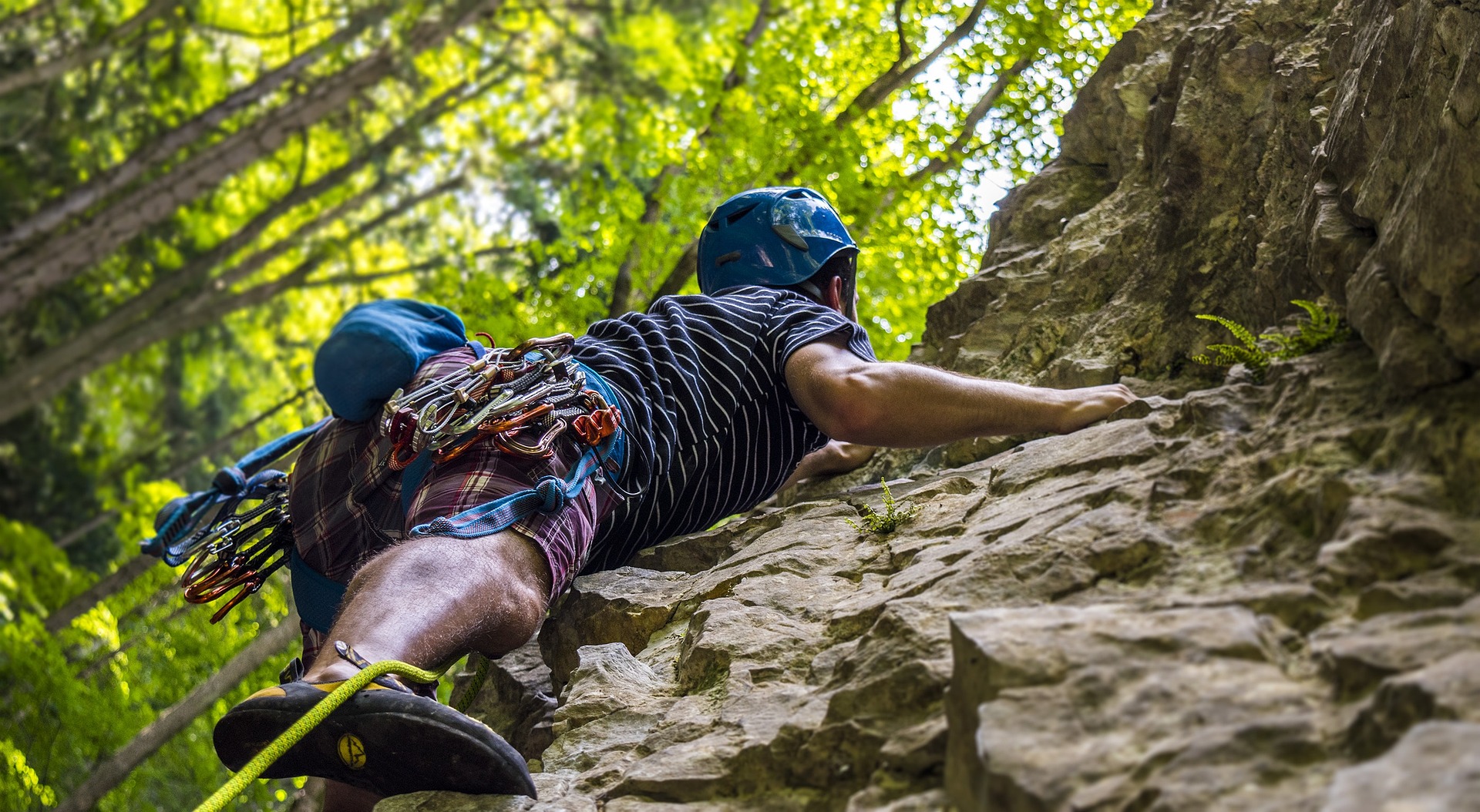Vertical Climbing: Scaling New Heights in Sport
Vertical climbing, a discipline that merges athleticism with gravity-defying feats, has been quietly ascending the ranks of popular sports. This unique pursuit challenges individuals to conquer sheer rock faces, artificial walls, and even urban structures, pushing the boundaries of human capability. As we delve into the world of vertical climbing, we'll explore its rich history, diverse techniques, and the profound impact it's having on both recreational enthusiasts and elite athletes alike.

The early 20th century saw a surge in interest, with climbers pushing the limits of what was possible on rock. Figures like Royal Robbins and Yvon Chouinard in Yosemite Valley revolutionized climbing ethics and equipment, introducing concepts like clean climbing and developing tools that would change the sport forever. This period also saw the birth of bouldering, a form of climbing focused on short, intense problems close to the ground, which would later become a discipline in its own right.
As climbing techniques and safety gear improved, the sport began to attract a wider audience. The 1960s and 70s witnessed a boom in outdoor climbing, with new routes being established across the globe. This era also saw the emergence of indoor climbing gyms, making the sport accessible to urban dwellers and paving the way for its current popularity.
The Vertical Spectrum: Disciplines and Styles
Vertical climbing encompasses a diverse range of disciplines, each with its own unique challenges and appeal. Traditional or “trad” climbing involves ascending routes while placing protective gear into natural features of the rock. This style demands not only physical prowess but also a deep understanding of gear placement and risk management. Sport climbing, by contrast, relies on pre-placed bolts for protection, allowing climbers to focus more on the physical aspects of the ascent.
Bouldering, once a training tool for larger climbs, has evolved into a standalone discipline. It emphasizes power, problem-solving, and technique over a short sequence of moves. The low height and use of crash pads make it accessible to beginners while still offering immense challenges for experts.
Ice climbing and mixed climbing push the boundaries of the sport into frozen terrain. These disciplines require specialized tools and techniques to ascend frozen waterfalls and icy mountain faces. The ephemeral nature of ice formations adds an extra layer of complexity and excitement to these pursuits.
Big wall climbing represents the ultimate test of endurance and self-sufficiency. Climbers spend days living on vertical faces, hauling gear and supplies as they inch their way up massive cliffs. Iconic locations like Yosemite’s El Capitan have become pilgrimage sites for big wall enthusiasts from around the world.
The Physics and Physiology of Vertical Movement
At its core, vertical climbing is a complex interplay of physics and human physiology. Climbers must constantly negotiate the forces of gravity, friction, and momentum as they move up a wall. The concept of center of gravity plays a crucial role, with climbers learning to position their bodies to maintain balance and conserve energy.
From a physiological standpoint, climbing engages virtually every muscle group in the body. The forearms and fingers bear much of the load, developing incredible strength and endurance over time. Core muscles work constantly to maintain body position, while legs provide the primary driving force for upward movement. This full-body engagement makes climbing an exceptionally effective form of exercise, combining strength training, flexibility, and cardiovascular fitness.
The mental aspect of climbing is equally important. Problem-solving skills are constantly tested as climbers navigate routes, deciding on the most efficient sequence of moves. The sport also demands high levels of focus and emotional control, particularly when dealing with exposure to height or difficult moves. This combination of physical and mental challenges contributes to climbing’s reputation as a holistic form of exercise and personal development.
Training for the Vertical: Methods and Madness
As vertical climbing has evolved, so too have the training methods employed by its practitioners. Modern climbing gyms offer a controlled environment for honing skills and building strength. These facilities feature walls with varying angles and hold types, allowing climbers to simulate a wide range of outdoor conditions.
Fingerboards and campus boards have become staples of climbing-specific training. These devices target finger strength and explosive power, crucial components for tackling difficult moves. System walls, featuring symmetrical hold patterns, allow climbers to work on technique and movement patterns in a systematic way.
Cross-training has also become increasingly important in the world of vertical climbing. Many climbers incorporate yoga for flexibility and body awareness, weight training for overall strength, and cardio exercises to improve endurance. Nutrition and recovery strategies play a vital role, with climbers paying close attention to factors like hydration, electrolyte balance, and proper fueling for long days on the wall.
Mental training techniques borrowed from sports psychology have found their way into climbing regimens. Visualization, positive self-talk, and mindfulness practices are used to overcome fear, improve focus, and enhance overall performance. Some climbers even work with sports psychologists to develop personalized mental strategies for tackling challenging routes or competition scenarios.
The Vertical Community: Culture and Conservation
One of the most striking aspects of vertical climbing is the strong sense of community it fosters. Climbing partners often form deep bonds, relying on each other for safety and support in high-stakes situations. This camaraderie extends to the broader climbing community, with climbers around the world sharing a common language and set of values.
Climbing ethics play a significant role in shaping the sport’s culture. Concepts like “leave no trace” and minimizing impact on the natural environment are deeply ingrained. Many climbers actively participate in conservation efforts, working to protect the outdoor spaces that make their sport possible.
The development of new climbing areas often involves complex negotiations between climbers, land managers, and local communities. As the sport grows in popularity, balancing access with conservation has become an increasingly important issue. Many climbing organizations now focus on education and stewardship programs to ensure sustainable growth of the sport.
Competitive Climbing: From Crags to Olympic Stage
While many climbers pursue the sport purely for personal enjoyment and challenge, competitive climbing has grown into a significant aspect of the vertical world. The International Federation of Sport Climbing (IFSC) oversees world cup events in three disciplines: lead climbing, bouldering, and speed climbing.
Lead climbing competitions simulate the experience of climbing a difficult sport route, with climbers scored based on the highest hold reached. Bouldering competitions feature a series of short, intense problems that must be solved within a time limit. Speed climbing, perhaps the most spectator-friendly discipline, pits climbers against each other in head-to-head races up a standardized 15-meter wall.
The inclusion of sport climbing in the 2020 Tokyo Olympics (held in 2021 due to the COVID-19 pandemic) marked a major milestone for the sport. The Olympic format combined all three disciplines into a single event, crowning the most well-rounded climbers as champions. This exposure on the world stage has led to increased interest in climbing and is likely to shape the future of the sport for years to come.
The Future of Vertical Pursuit
As vertical climbing continues to grow in popularity, it faces both opportunities and challenges. The increasing accessibility of indoor climbing gyms has introduced the sport to a wider audience than ever before. This growth has led to innovations in training techniques, gear design, and route setting, pushing the boundaries of what’s possible on vertical terrain.
Technology is playing an increasingly important role in the world of climbing. Wearable devices and smartphone apps allow climbers to track their progress and analyze their performance in detail. Virtual reality and augmented reality technologies are being explored as tools for route visualization and training.
Climate change presents a significant challenge to many aspects of outdoor climbing. Melting permafrost is destabilizing some alpine routes, while changing weather patterns affect ice climbing conditions. The climbing community is increasingly engaging with these issues, both in terms of adapting to changing conditions and advocating for environmental protection.
The future of competitive climbing is also evolving. The success of climbing’s Olympic debut has led to discussions about how to refine the competition format for future games. There’s ongoing debate about whether to separate the disciplines or continue with the combined format, balancing the desire for specialization with the unique challenge of all-around climbing prowess.
Scaling New Heights: The Ongoing Evolution of Vertical Climbing
Vertical climbing stands at an exciting crossroads. Its roots in adventure and exploration remain strong, even as it embraces new technologies and competitive formats. The sport continues to attract individuals seeking personal challenge, connection with nature, and a unique form of physical and mental development.
As climbing gyms proliferate in urban areas, the sport is becoming increasingly diverse and inclusive. Efforts are being made to break down barriers to entry and create welcoming spaces for climbers of all backgrounds. This broadening of the climbing community brings fresh perspectives and energy to the sport.
The relationship between indoor and outdoor climbing continues to evolve. While many climbers transition from gym to crag, there’s also a growing subset of climbers who primarily or exclusively climb indoors. This shift has implications for everything from gear design to environmental impact management.
Innovation in climbing gear shows no signs of slowing down. Advances in materials science are leading to stronger, lighter equipment. Safety devices are becoming more sophisticated, potentially reducing risks in both sport and traditional climbing. These technological developments are enabling climbers to push the boundaries of difficulty and tackle previously impossible routes.
The Psychological Landscape of Vertical Climbing
The mental aspects of vertical climbing deserve deeper exploration, as they often prove to be the limiting factor in a climber’s progression. Fear management is a crucial skill, particularly when dealing with exposure to height or committing moves. Experienced climbers develop strategies to control their fear response, allowing them to perform in high-stress situations.
The concept of “flow state” is frequently discussed in climbing circles. This psychological state of full immersion and focused motivation can lead to peak performance and profound experiences of joy and satisfaction. Many climbers describe their most memorable ascents as times when they achieved this state of flow, moving up the wall with a sense of effortless mastery.
Decision-making under pressure is another critical mental skill in vertical climbing. Whether it’s choosing the correct sequence of moves, deciding whether to push on or retreat in deteriorating weather, or making split-second judgments about gear placements, climbers must constantly evaluate risks and make informed choices.
The long-term psychological benefits of climbing are also noteworthy. Many practitioners report improved self-confidence, better stress management skills, and enhanced problem-solving abilities that transfer to other areas of life. The process of setting and achieving climbing goals can be a powerful tool for personal growth and self-discovery.
Vertical Climbing in Therapeutic Contexts
The physical and mental challenges of vertical climbing have led to its increasing use in therapeutic settings. Adaptive climbing programs have been developed for individuals with physical disabilities, providing opportunities for strength building, improved mobility, and increased independence.
In mental health contexts, climbing is being explored as a complementary therapy for conditions such as depression, anxiety, and PTSD. The combination of physical exertion, problem-solving, and supportive social interaction can be particularly beneficial. Some therapists are even incorporating climbing into their practice, using it as a metaphor for overcoming life’s challenges.
Climbing is also finding applications in corporate team-building and leadership development programs. The trust and communication required between climbing partners can translate directly to improved workplace relationships. Problem-solving skills honed on the wall can enhance creative thinking and project management abilities.
The Environmental Impact and Sustainability Challenge
As vertical climbing continues to grow in popularity, its environmental impact has come under increased scrutiny. High-traffic climbing areas can suffer from erosion, vegetation damage, and disturbance to wildlife. The climbing community has responded with various initiatives to mitigate these impacts, including trail maintenance, seasonal closures to protect nesting birds, and education programs on low-impact climbing techniques.
The production and disposal of climbing gear also present environmental challenges. Many climbers are now calling for more sustainable manufacturing processes and materials. Some companies are experimenting with recycled or biodegradable materials for climbing holds, ropes, and other equipment.
Climate change poses a significant threat to many climbing areas, particularly in alpine and polar regions. Melting glaciers and thawing permafrost are altering the landscape and increasing natural hazards. The climbing community is increasingly engaged in climate activism, recognizing the need to protect the environments that make their sport possible.
The Role of Media in Shaping Vertical Climbing Culture
Media representation has played a significant role in the evolution of vertical climbing culture. Climbing films and documentaries have brought the sport to a wider audience, showcasing its drama and beauty. Social media platforms have created new ways for climbers to share their experiences, find partners, and stay informed about conditions and access issues.
However, the increased visibility of climbing through media has also raised concerns. Some worry that the portrayal of extreme or risky climbing behavior could encourage inexperienced individuals to attempt climbs beyond their abilities. There’s an ongoing discussion within the community about how to balance the inspiration provided by media coverage with responsible messaging about risk management and proper training.
The Economic Impact of Vertical Climbing
The growth of vertical climbing has had significant economic implications. The indoor climbing gym industry has exploded, with new facilities opening in cities around the world. These gyms often serve as community hubs, offering classes, events, and social spaces in addition to climbing.
Outdoor climbing destinations have seen increased tourism, bringing both opportunities and challenges to local communities. Some areas have embraced climbing as an economic driver, while others grapple with issues of overcrowding and resource strain.
The climbing gear industry continues to expand, with both established companies and innovative startups competing in a growing market. As the sport becomes more mainstream, there’s also been growth in adjacent industries such as climbing-specific fitness programs, nutrition products, and travel services.
Vertical Climbing and Urban Planning
The popularity of climbing is beginning to influence urban planning and architecture. Some cities are incorporating climbing walls into public parks and recreational facilities. Bouldering blocks are appearing in urban green spaces, providing accessible opportunities for residents to experience climbing.
In some cases, climbing is being integrated into building design. Structures with climbable facades are being proposed as a way to combine functionality with recreation. These developments raise interesting questions about the future intersection of climbing and urban environments.
The Global Perspective: Vertical Climbing Around the World
While vertical climbing has its roots in Western mountaineering traditions, it has become a truly global sport. Different regions have developed unique climbing cultures and styles, influenced by local geography, weather patterns, and cultural factors.
In some countries, government support has played a significant role in the development of climbing. For example, Japan and South Korea have invested heavily in training facilities and programs, contributing to their strong performances in international competitions.
The growth of climbing in developing countries presents both opportunities and challenges. Access to equipment and training can be limited, but there’s also potential for climbing to contribute to local economies through tourism and related industries.
Conclusion: The Continuing Ascent of Vertical Climbing
Vertical climbing, in all its forms, continues to captivate and challenge humans in unique ways. From the physical demands it places on the body to the mental resilience it requires, climbing offers a holistic form of engagement that few other activities can match. As the sport evolves, it faces important questions about sustainability, inclusivity, and its place in the broader cultural landscape.
The future of vertical climbing looks bright, with ongoing innovations in technology, training methods, and competition formats. As more people discover the joys and challenges of moving vertically, the sport is likely to continue its upward trajectory. Whether on natural rock faces, artificial walls, or urban structures, the act of climbing speaks to something fundamental in the human spirit – the desire to explore, to challenge oneself, and to reach new heights, both literally and figuratively.
As we look to the future, it’s clear that vertical climbing will continue to push the boundaries of human potential. From elite athletes setting new standards of difficulty to weekend warriors finding personal growth on their local crag, the vertical world offers endless possibilities for adventure, community, and self-discovery. The ongoing story of vertical climbing is one of constant innovation, adaptation, and the enduring human drive to reach ever greater heights.





